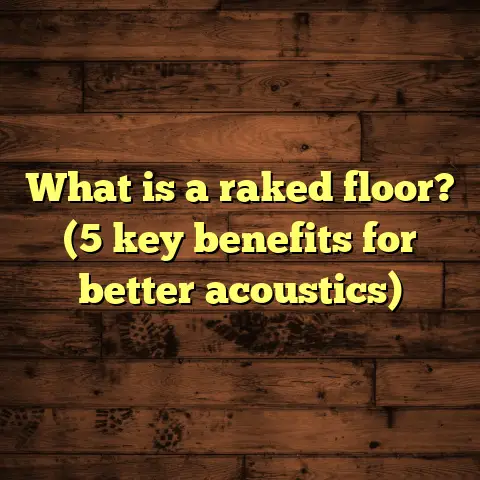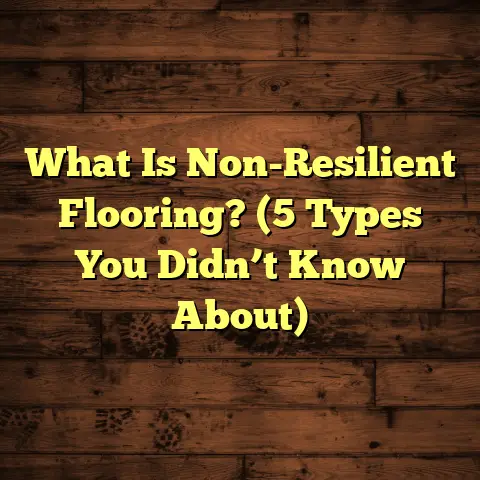What is Carpet Tile Flooring? (5 Benefits You Didn’t Expect)
Investing in flooring isn’t just about aesthetics—it’s about making a choice that impacts your daily living, comfort, and the overall vibe of your space for years. When you think about flooring, you probably picture hardwood, laminate, or traditional wall-to-wall carpet. But over the years, one option has consistently stood out to me as both practical and surprisingly versatile: carpet tile flooring. At first glance, carpet tiles might seem like a niche or commercial-only product, but after working with them extensively, I can tell you they offer benefits you might not expect. So what are carpet tiles exactly? And why have they become my go-to recommendation for so many projects?
What is Carpet Tile Flooring?
Let’s start with the basics. Carpet tile flooring is made up of individual square pieces of carpet—typically measuring between 18 and 24 inches on each side—that fit together to cover a floor surface. Unlike traditional wall-to-wall carpet, which comes in big rolls and is installed in one piece across the room, carpet tiles are modular. You install them piece by piece, almost like large puzzle pieces.
The tiles themselves are made from various materials—nylon is the most common because it’s durable and stain-resistant, but you’ll also find polyester, olefin, or even wool blends. The backing of these tiles can vary too: some come with adhesive on the back (peel-and-stick), others require double-sided tape or glue-down adhesives for installation.
What makes carpet tiles unique is their modularity. You can mix colors and textures to create custom patterns or simply use a uniform style throughout a room. This flexibility is something you won’t get with traditional carpets or even hardwood floors.
When I first encountered carpet tiles years ago while renovating a small office, I was a bit skeptical. How could something that breaks apart into squares perform as well as a continuous carpet? But after installing them myself and seeing how easy it was to replace damaged sections without ripping up an entire floor, I quickly became a fan.
How Carpet Tiles Compare to Other Flooring Options
Over my years in flooring installation and consulting, I’ve installed hardwood, laminate, vinyl plank, wall-to-wall carpets, ceramic tile—you name it. Each has its place depending on style, budget, and function. But here’s how carpet tiles stack up against some popular alternatives:
Hardwood vs Carpet Tiles
Hardwood is gorgeous and classic but can be expensive and sensitive to moisture. Installation requires skill and takes time. Plus, scratches happen.
Carpet tiles offer a softer feel underfoot and warmth that hardwood doesn’t provide. They’re easier to install (even DIY-friendly in many cases) and quicker to repair if damaged.
Laminate Flooring vs Carpet Tiles
Laminate mimics hardwood at a lower cost and is fairly durable. It’s easy to clean but can feel cold and hard underfoot.
Carpet tiles add cushioning and sound absorption that laminate lacks. They also provide better traction—less slipping.
Traditional Wall-to-Wall Carpet vs Carpet Tiles
This is the most direct comparison. Wall-to-wall carpet creates a seamless look but can be costly to install and maintain. Stains can mean expensive cleaning or full replacement.
Carpet tiles let you replace only stained or damaged sections, saving money long-term. Plus, installation is faster and less messy.
Vinyl Plank vs Carpet Tiles
Vinyl planks are water-resistant and durable but again lack the softness and noise reduction properties of carpet tiles.
Carpet tiles are better in rooms where comfort matters—think offices, bedrooms, playrooms.
My Personal Journey with Carpet Tiles
I’ll share a bit about how I started using carpet tiles more frequently. Early in my career, I mostly worked with hardwood and traditional carpets—because clients wanted that “classic” look or easy maintenance.
Then I took on a project for a mid-sized tech startup renovating their office space. They wanted something durable, affordable, and stylish that wouldn’t disrupt their daily work too much during installation.
We chose carpet tiles with a geometric pattern mixing dark gray and blue hues. I still remember how quickly we installed the tiles—less than a day for 1,200 square feet—and how easy it was to work around desks without heavy tools.
A few months later, when they spilled coffee in one corner, they called me to replace just those stained tiles. It took me 20 minutes to swap out six squares rather than removing an entire room’s carpeting.
That project changed how I viewed carpet tiles completely. I started recommending them for both residential and commercial jobs—not just as an alternative but sometimes as the best solution.
Five Benefits of Carpet Tile Flooring You Didn’t Expect
You might think you know about carpet tiles already if you’ve seen them in offices or schools—but here are five benefits I’ve discovered that most people overlook.
1. Waste Reduction and Environmental Impact
Did you know traditional carpet installation wastes up to 20% of materials? Because carpets come in large rolls that need cutting to fit rooms precisely, leftover scraps often go straight to landfills.
Carpet tiles minimize this waste since you only order exactly what you need in modular squares.
What’s more interesting is that many manufacturers now produce carpet tiles using recycled nylon fibers or backing materials designed for recycling after use.
Take Interface—one of the largest carpet tile producers worldwide—they’ve reduced carbon emissions by 96% over two decades through sustainable production methods.
Using recycled carpet tiles isn’t just good for the planet; it’s also cost-effective because you avoid overbuying materials that might never get used.
In my eco-conscious projects, I often specify recycled-content carpet tiles. Clients appreciate knowing their floors contribute to sustainability goals without sacrificing style or durability.
2. Easy Repairs Save Time and Money
Carpets get stained or worn out over time—it’s inevitable. But what if fixing those issues didn’t mean replacing an entire room’s flooring?
That’s exactly what carpet tiles offer: spot repairs at a fraction of the cost.
In my experience working with homes with kids or pets, spills happen regularly. Instead of calling professional cleaners repeatedly or planning expensive replacements every couple of years, swapping out just a few damaged tiles does the trick.
Industry data supports this: replacing carpet tiles averages $5-$15 per square foot including labor versus $10-$20 per square foot for full wall-to-wall carpet replacement.
One client told me she saved over $1,000 after her toddler’s paint spill by replacing just four stained tiles herself.
3. Design Flexibility You Can’t Beat
Ever wished you could design your floor like you did your walls or furniture? Carpet tiles let you play with patterns, colors, and textures without breaking the bank.
You could go classic with monochromatic layouts or bold by mixing bright colors into checkerboards or stripes.
Some offices I worked on used logo-shaped designs made from different colored tiles—something nearly impossible with traditional carpeting unless you order custom-made rugs at premium prices.
Even for homeowners wanting fun kids’ rooms or creative studios, this customization opens up possibilities many don’t realize exist with carpet flooring.
4. Improved Indoor Air Quality
Indoor air quality is a big one for me personally because I have allergies. Traditional carpets trap dust mites and allergens deep within their fibers. Cleaning helps but doesn’t eliminate these irritants fully.
Carpet tiles generally have lower pile heights and advanced backing technologies designed to reduce off-gassing of volatile organic compounds (VOCs).
Some brands offer low-VOC certified products tested to meet stringent air quality standards.
Research from the Carpet and Rug Institute showed that maintaining carpet tiles properly results in fewer airborne allergens compared to older wall-to-wall carpets.
After switching several clients’ spaces—especially nurseries and healthcare clinics—to low-VOC carpet tiles, I noticed fewer complaints about sneezing or odors.
5. Faster Installation Means Less Disruption
Time is often overlooked when choosing flooring but it matters—a lot—especially in businesses or busy homes.
Installing traditional wall-to-wall carpeting involves removing old floors, prepping subfloors, laying down padding, stretching the carpet correctly—it can take days depending on room size.
Carpet tiles roll out quickly with minimal prep work needed if the subfloor is clean and level.
In commercial settings where downtime means lost revenue, this speed makes a huge difference.
For instance, I recently helped renovate an open-plan office with over 1,000 square feet of carpet tile installed in under eight hours total—allowing employees back at work by next morning.
Homeowners benefit too: less mess, noise, and disruption when installing modular tiles compared to ripping out old carpeting entirely.
What About Cost? How I Use FloorTally for Accurate Estimates
I won’t sugarcoat it—estimating flooring costs can feel unpredictable sometimes because prices depend on many factors: materials chosen, labor rates by region, expected waste percentages, prep work needed…
Over time I’ve found tools like FloorTally invaluable for nailing down realistic budgets quickly and accurately.
FloorTally lets me input local labor costs alongside material prices so estimates reflect actual market conditions instead of rough guesses.
It also factors in waste percentages automatically—which is crucial for carpet tile projects because you want enough extra tiles on hand for future repairs without overspending upfront.
For example: When planning an office renovation recently using mid-grade nylon carpet tiles with a 7% waste factor included by FloorTally’s calculator—the final estimate was spot on with what we spent after purchase and installation.
Being able to show these detailed estimates to clients upfront builds trust and reduces surprises later on during billing or project management phases.
I use FloorTally not as a sales pitch but as essential project planning support that simplifies decisions around flooring types based on cost-effectiveness compared to alternatives like laminate or vinyl planks.
Installation Tips from My Experience
If you’re thinking about trying carpet tile installation yourself—or supervising your contractor—here are some tips I picked up along the way:
- Subfloor Prep Is Key: Make sure your subfloor is clean, dry, flat, and smooth before laying down any tiles. Uneven surfaces cause poor adhesion and uneven wear later on.
- Acclimate Tiles: Just like hardwood flooring needs to acclimate to indoor humidity levels before installation—carpet tiles benefit from sitting in the installation room for 24-48 hours beforehand to avoid expansion/contraction issues later.
- Choose Installation Method Wisely: Peel-and-stick tiles are great for quick DIY jobs but might not hold up as well long-term in high-traffic commercial spaces where glue-down adhesives provide stronger bonds.
- Plan Layout Carefully: Start from the center of the room or a focal point for best visual balance. Use chalk lines or laser guides for straight rows especially if mixing patterns/colors.
- Use Proper Tools: A sharp utility knife for trimming edges plus knee pads make installation easier on your body and help achieve professional-looking results even if you’re new at this.
Case Study: Office Renovation Where Carpet Tiles Shined
Here’s an actual story from one of my recent projects that highlights why I trust carpet tiles so much:
A software company wanted an affordable upgrade to their tired office flooring without closing down their space for more than a day. They had tried hardwood before but found it too cold underfoot especially in winter months. Wall-to-wall carpet was expensive to replace fully plus heavy odors from old padding lingered even after cleaning.
We recommended commercial-grade nylon carpet tiles with stain-resistant coatings arranged in alternating dark charcoal and blue squares forming subtle grid patterns throughout open work areas.
The install took less than one full day including prep. Employees came back the next morning with minimal disruption reported.
Six months later when someone spilled soda near the kitchen corner—a common accident—we replaced five stained tiles quickly without disrupting workstations around them.
The client reported improved employee comfort from better acoustics (tiles absorb sound more than hard floors) plus lower maintenance costs compared to their previous carpeting setup.
Common Questions People Ask Me About Carpet Tiles
Q: How long do carpet tiles last?
A: With proper care and quality materials like nylon fibers, carpet tiles can last 10-15 years or more—comparable to traditional carpets but with easier maintenance benefits built-in.
Q: Are they suitable for homes?
A: Absolutely! Many homeowners overlook carpet tiles thinking they’re only for offices or commercial spaces—but they’re great in basements, kids’ rooms, home offices—even high-traffic hallways where you want comfort plus durability.
Q: Can I install them myself?
A: If you’re handy with basic tools and follow manufacturer instructions carefully, peel-and-stick carpet tiles are among the easiest flooring types for DIYers to install themselves. Glue-down methods require more expertise but aren’t impossible if you have patience.
Q: Do they trap dirt like regular carpets?
A: Not necessarily. Lower pile heights mean dirt sits more on top making vacuuming easier. Also many modern designs include stain-resistant treatments reducing deep penetration of spills or dirt particles.
Q: What about sound insulation?
A: Carpet tiles absorb sound better than hard surfaces like tile or hardwood which makes them ideal in multi-level buildings or noisy offices seeking quieter environments without costly acoustic panels elsewhere.
Final Thoughts From My Experience
Choosing flooring is one of those tough decisions because you want something that looks good but holds up over time without breaking the bank every few years. Carpet tile flooring brings together durability, style flexibility, environmental friendliness—and practical advantages like easy repairs that not many other options offer simultaneously.
Whether you’re updating your home office floor or outfitting an entire commercial building space—carpet tiles deserve serious consideration as a smart investment that pays off well beyond initial installation day.
And if budget planning stresses you out like it did me early on? Don’t hesitate to use tools like FloorTally to get clear numbers upfront based on your local market conditions instead of guessing blindly between options like laminate vs tile vs modular carpet squares.
If you have any questions about specific brands, installation techniques, or want help comparing flooring solutions based on your unique space—I’m always happy to chat more! Flooring doesn’t have to be overwhelming once you know what’s out there—and carpet tile flooring just might be your next best move.





